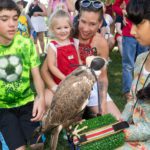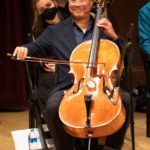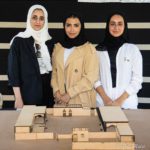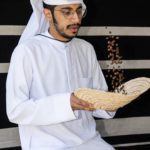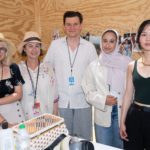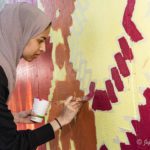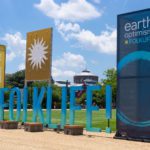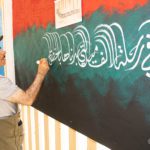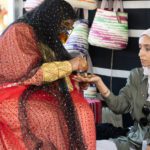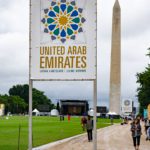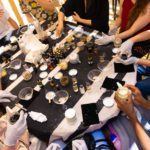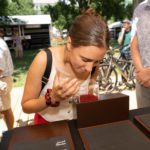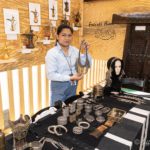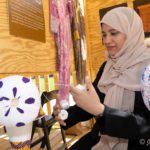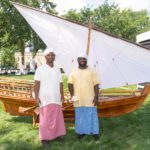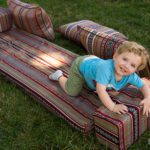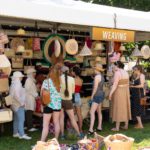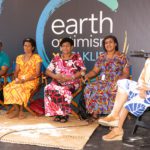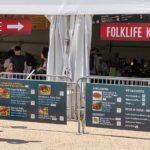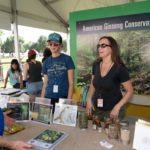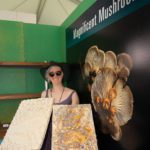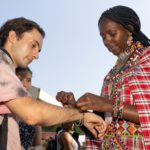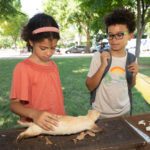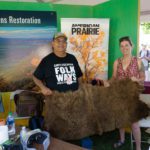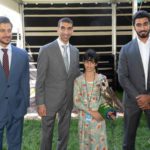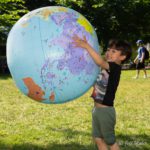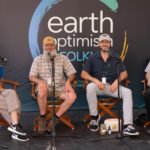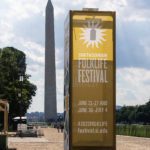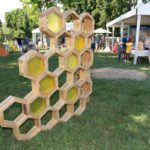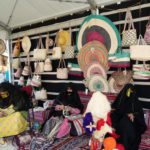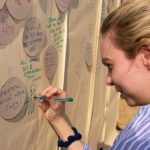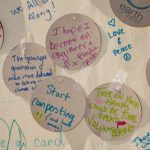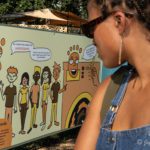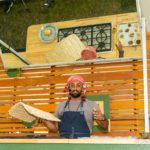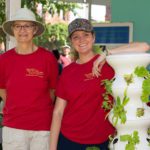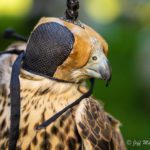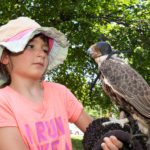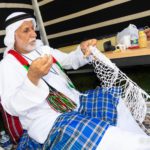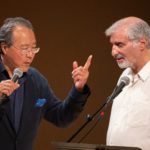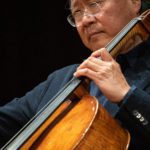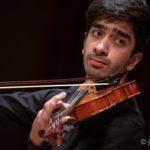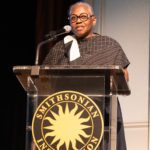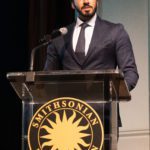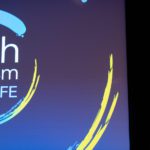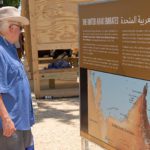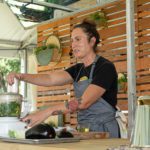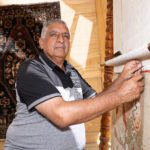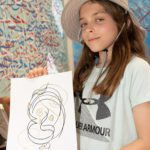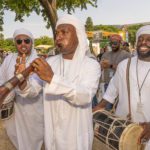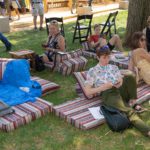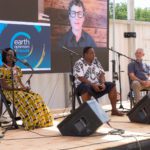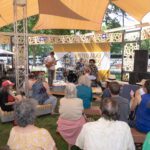Smithsonian Folklife Festival Returns to National Mall (photos)
By • June 26, 2022 0 4014
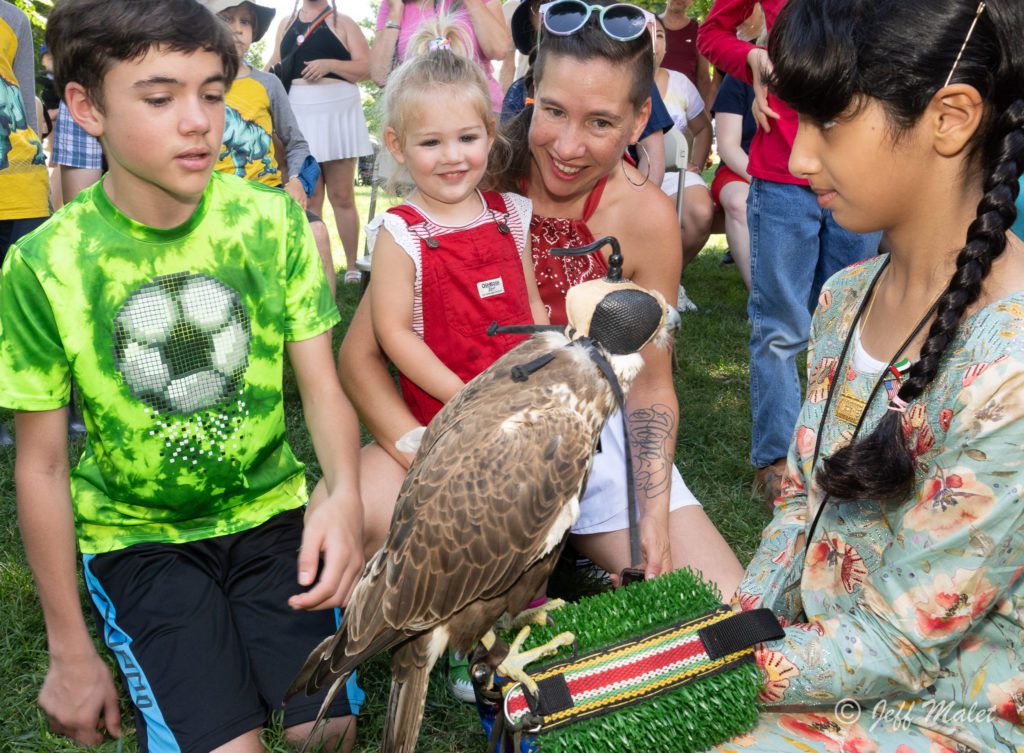
The popular Smithsonian Folklife Festival this week returned live to the National Mall in Washington D.C. after a two year hiatus. Established in 1967, the gathering on the National Mall in Washington D.C. honors contemporary living cultural traditions and celebrates those who practice and sustain them. This year’s edition features the cultural traditions of the United Arab Emirates (UAE) and the Smithsonian’s Earth Optimism program highlighting the importance of culture and community in creating a sustainable future.
The Folklife Festival officially got underway with an evening concert Wednesday, June 22 featuring famed cellist Yo-Yo Ma, followed the next morning with an official opening ceremony inside the Smithsonian Freer Gallery or Art auditorium.
The Festival occupies space between 7th and 12th Street in front of the Smithsonian Castle and the National Museum of Natural History. After a customery planned two day break in the schedule on June 28-29, the Festival will recommence on Thursday June 30 and will run thru July 4, Programming will always start at 11 a.m. and run until 5 p.m. daily. Special performances from the lawn are scheduled during most evenings at 6:30 p.m. See the full schedule here. For the first time, concerts and selected panel discussions will be live-streamed on youtube.
Earth Optimism
Many of us have adopted a somewhat negative outlook regarding the impact of human habitation on our planet. Earth Optimism takes dead aim to minimize this defeatist mindset by emphasizing an alternative narrative to mainstream environmental news by highlighting the potential for humans to positively impact the environment by making small changes at individual and community levels.
Five years ago marked the launch of an Earth Optimism Summit (promoted jointly by the Smithsonian and the Cambridge Conservation Initiative) featuring many of the leading world conservationists.
“Earth Optimism is the opposite of Earth Pessimism” said Ruth Anna Stolk, a co-founder of the Earth Optimism Project. She directed the Smithsonian’s Earth Optimism Summits and related initiatives until 2022. Stolk put together many of the panel discussions at the 2022 Folklife Festival. “We had [the 2017] summit over in the International Trade Center next door [to the March for Science on Earth Day]. We were jammed. We had 1500 people, but we reached 200 million. It was the first time we had done a live stream. We were shocked at how many people tuned in and looked at what we were doing. We had 300 speakers who fought their way in to tell their stories and had to turn many away.” The Earth Optimism initiative which was launched by the Smithsonian has now been adopted by institutions all over the world and has taken on a life of its own in grass roots fashion.
Further commenting on the Earth Optimism initiative, Stolk added “It’s really telling a story about what is working in conservation as opposed to what’s not working. We think of the Festival as a country, a country of people who are doing things to make the planet a better place…. the idea was to put a mirror to the rest of the world and see what was out there. See if we could bring together the people who are doing successful things so they can talk to each other and then maybe things can get replicated… it’s really that simple.” It’s about sharing success stories.
‘Earth Optimism’ was originally scheduled to be a main theme of the 2020 Smithsonian Folklife Festival which had to be scrapped as a live event in favor of virtual programs due to the pandemic.
Erin Chapman is a co-curator of the Earth Optimism program at the Folklife Festival. “We are highlighting success stories and solutions in the conservation and environmental space with the hope of inspiring people to take action. It’s about people being empowered to act and to live for each other in the environment,” said Chapman. At the 2017 Summit, and a digital summit in 2020, “it was people just talking, In the Folklife Festival we’ve taken that same idea and we’ve put it into a physical space so that people can engage with these stories.”
Take the example of oyster restoration where “they’ve made huge strides in the Chesapeake Bay and bringing oysters back because their populations were decimated…. There are organizations and people that are taking action to bring the oyster population back to the bay, to filter our waters and make it a healthier place for us to live. And so that message is being shared here, so that people can do oyster gardening if they have waterfront property. They can do it in stores, in restaurants that they need to give those [oyster] shells back to keep the populations going.” Oyster restoration is but one of many positive examples of environmental success stories on display at the Folklife Festival this year.
“So to me, Earth optimism is inspiring people to action by showing them what they can do, by showing them that people are taking actions and it is working in helping preserve ecosystems and species. To me, it’s a change in attitude and behavior [so people can say] ‘I can do something meaningful.'”
United Arab Emirates (UAE)
The UAE, situated in the Middle East on the Saudi Peninsula, is an elective monarchy formed from a federation of seven emirates in 1972. The land has been inhabited for over 125,000 years at the the crossroads of trading for many civilizations, including those of Mesopotamia, Persia, and India.
The center of the Festival is the wooden majlis, which is a house-like structure that contains several comfortable sitting rooms for visitors to walk through and learn about different aspects of UAE culture.
Michele Bambling is a co-curator of the UAE Exhibition at the Folklife Festival. She currently calls the UAE her home where she is a visiting professor at New York University Abu Dhabi. At the Festival, she is accompanied by several of her students. “The UAE has a very rich and strong tradition of living in response to nature, of finding ways to survive in a harsh environment and living through creativity and knowledge. So you can see here at the Festival, many of those ways, which are traditional, are still being passed down from generation to generation. For example, the weaving called sadu and the idea about henna, which was also not only a spiritual form of protection, but also a form of preventing sunburn. The songs of the pearl divers and the sailors. Those have been transmitted orally. So all of those traditions are being presented, but so are innovative ways in which the essence of those traditions are informing contemporary design ideas and forming all sorts of new strategies for developing many aspects across different disciplines.” The UAE is becoming very much a modernized and progressive country. “So what we’re trying to do is show the link between the past, the present and the future in ways in which even if the traditional seafaring skills and the traditional forms of adornment aren’t the norm any longer, they’d still survive as as cultural heritage forms But they also actively inform contemporary design and contemporary strategies for living close to the environment. “
“The Festival itself is divided into a theme of three clusters of ideas. One is place to introduce to the public the place, the geographic place of the UAE, with its vast desert and oasis, with its mountainous and rocky ranges and its coast along the peninsula. In the area of place, we have different activations, such as the culture of pearls, the music of pearls and celestial navigation, and the idea of home and placemaking, where we have a collector who has brought some of the very old doors from actual homes…. We have all sorts of natural life being represented, such as falconry and conservation. So there are many educational and informative and important activations around nature. We have a mangrove section as well [and a] fisheries section. And so those constitute and are organized to express place.”
We also have in the center something very universally relevant, which is creativity, the idea of human creativity in response to nature and the development of cultural knowledge. And in that area we have ideas about language communication, we have traditional calligraphy, we have a letter press. We have a very interesting distillation around adornment and expressions of human identity through perfume and family, making recipes and finding ingredients and how they combine to make all sorts of perfumes from elements of nature and adornment with the weaving technique which is used to decorate regular decorative garments.”
“The third area is belonging. So the sense of belonging to the place and interacting through creative forms such as language and expression of identity…. for example, we have a section dedicated to family photographs and oral histories. We also have spices [which are] tied to the foodways kitchens. The spices are reflecting the diversity of the culinary experiences one finds in the UAE. And there are many, many spices placed in bottles that create a spectrum of color. We have ceramics and we have some from weaving and all of these different forms of integration of people.”
“So the entire festival encourages curiosity, sharing of ideas, discovery of the UAE and the discovery of where we come from,” concluded UAE co-curator Bambling.
View a slideshow of Jeff Malet’s photos from the Smithsonian Folklife Festival, all taken between June 22-25, 2022, by clicking on the photo icons below.
- Athanasia (age 2), Stephen (14) and mom Hanna from D.C. learn falconry from Osha Almansoori of Abu Dhabi. Falconry is an ancient sport embodying values of endurance and patience. Photo by Jeff Malet.
- Yo-Yo Ma performs on June 22 at the opeing evening concert inside the Smithsonian Museum of Natural History. Photo by Jeff Malet.
- Al Qubaisi House scale model : Zainab Al Blooki, Bashayer Al Korbi and Renad Abdul Jabbar. Photo by Jeff Malet.
- Demonstrating the making of Arabic coffee or gahwa, from raw green beans to fragrant brewed cup. Photo by Jeff Malet.
- Erin Chapman is a co-curator of the Earth Optimism program at the Folklife Festival. Photo by Jeff Malet.
- Michele Bambling (2nd left) with her students Emily Broad, Kacper Madejek, Maryam Al Huraiz and Yuxin Lin. Photo by Jeff Malet.
- Artist Afra Almheiri. Emerging UAE artists designed a mural for the Festival that is inspired by the textures, colors, and places of everyday life in Dubai.. Photo by Jeff Malet.
- The popular Smithsonian Folklife Festival this week returned live to the National Mall in Washington D.C. after a two year hiatus. Photo by Jeff Malet.
- Master calligrapher Mohammed Mandi teaches workshop participants the basics of Arabic calligraphy and to write a word. Photo by Jeff Malet..
- Master calligrapher Mohammed Mandi teaches workshop participants the basics of Arabic calligraphy and to write a word. Photo by Jeff Malet..
- Umm Saeed uses homemade henna harvested and prepared from her own trees. Learn the meanings of her traditional designs for hands and feet.. Photo by Jeff Malet.
- Photo by Jeff Malet.
- A daily workshop will introduce you to the ingredients and key notes of traditional Arab perfumes, the techniques of incense making, and the emotional stories of scent. Photo by Jeff Malet.
- Fiona from D.C. smells cloves and other frangrances. on display. Photo by Jeff Malet.
- Joanna Vidal. Jewelry marks each each life occasion for Emirati women. On display from the collection of Dr. Ahmed M. Alkhoori. Photo by Jeff Malet.
- Ayesha Ahmed Almarar demonstrates the making of Telli which is used to adorn women’s clothing. Photo by Jeff Malet.
- Ari (DC) and Emily (LA) examine the Sustainable Living Exhibit showcasing from macro to microeveryday ways you can make your living more sustainable Photo by Jeff Malet.
- Pearl divers pose in front of their boat. Photo by Jeff Malet.
- Simon, age 2, from Alexandria Va. stretches out on a Jasla, traditional seat. Photo by Jeff Malet.
- Traditional weaving from palm leaves attracks a crowd. Photo by Jeff Malet.
- Kalesi Buka, Litiana Tiqe and Temalese Vere. These are the mat weavers from Rise Beyond the Reef in Fiji . Climate change is disporportioniately affecting the island nations, such as Fiji. Photo by Jeff Malet.
- Visit the Folklife Kitchen for a taste of the United Arab Emirates and local dishes that tell a story of sustainability and creativity. Photo by Jeff Malet.
- Carole Daniels of Shady Grove Botanicals demonstrates Ginseng Conservation. Photo by Jeff Malet.
- Lewis Linker. The Chesapeake Bay—the largest estuary in the United States—is an incredibly complex ecosystem. The Bay and its rivers, wetlands and forests provide homes, food and protection for countless animals and plants. Photo by Jeff Malet.
- Self described fungus artist. Photo by Jeff Malet.
- Diego from D.C. receives a beaded bracelet from Simaloi Saitoti Maasi Mara beadworking. Photo by Jeff Malet.
- Elle (8) and Owen (9) from North Bergen N.J. examine a prairie dog at the Great Plains Restauration exhibit. Photo by Jeff Malet.
- David Crasco and Katie Beattie with Great Plains Restoration Photo by Jeff Malet.
- A delegation from the UAE Embassy including Mubarak Al Nakhi, Undersecretary at Ministry of Culture visits Folklife. Photo by Jeff Malet.
- Alan, age 4 from Rockville Md. is saving the world. Many educational activites for kids at Folklife. Photo by Jeff Malet.
- Forest Pharmacy panel discussion. Photo by Jeff Malet..
- gelato. Photo by Jeff Malet..
- Photo by Jeff Malet.
- The Smithsonian has an ongoing program promoting native bee populations.. Meet the beekeeper from Hatta Honey in the UAE’s mountain region, and taste the three distinctive flavors of honey produced from native plants.. Photo by Jeff Malet.
- Traditional weaving from palm leaves.. Photo by Jeff Malet.
- Ally anwers the question “What’ is your hope for the future?” Photo by Jeff Malet.
- Attendees are asked”What steps will you take to reduce your eco footprint?” Photo by Jeff Malet.
- Walking along the Sustainable Pathway. Photo by Jeff Malet.
- Cool water is availble free for attendees. But bring an empty water bottle. Photo by Jeff Malet.
- Unanimously declared “best chef in the family,” Ahmed Al Marar joins us to showcase traditional Bedouin (“desert dweller”) cooking techniques. Photo by Jeff Malet.
- From the University of the District of Columbia show their vertical hydroponic system Photo by Jeff Malet.
- Falconry is an ancient sport embodying values of endurance and patience. Photo by Jeff Malet.
- Billie , age 7, from McLean Va. gets to hold a falcon. Falconry is an ancient sport embodying values of endurance and patience. Photo by Jeff Malet..
- Weaving a dean, a basket to collect oyster shells. Photo by Jeff Malet.
- YoYo Ma and Dr. Richard Kurin. Photo by Jeff Malet.
- Famed cellist Yo-Yo Ma performs at the opening concert. Photo by Jeff Malet..
- Mehran Fanoos performs during “The GIfts We Carry: Sounds of Migration and Memory. Photo by Jeff Malet.
- Sabrina Lynn Motley is the director of the Smithsonian Folklife Festival at the Center for. Folklife and Cultural Heritage.. Here speaking at the opening ceremony on June 23. Photo by Jeff Malet.
- Mubarak Al Nakhi, Undersecretary at Ministry of Culture and Knowledge development Ministry of Culture and Youth (MCY) Brunel University United Arab Emirates Photo by Jeff Malet.
- Earth Optimism co-founder Ruth Stolk speaking during the opening ceremony on June 23.
- The UAE, situated in the Middle East on the Saudi Peninsula, is an elective monarchy formed from a federation of seven emirates in 1972. Photo by Jeff Malet..
- Move like a mangrove, dance like a plant! Join local dancers from Local Motion Project as they express Earth Optimism through dance!. Photo by Jeff Malet.
- Elyssa Kaplan – Culinary Operations Manager at Jose Andres’ World Central Kitchen. Photo by Jeff Malet.
- Carpet weaving by Enayatullah Enayat. Photo by Jeff Malet.
- Abby, age 7 from Parsippany N.J. displays her name written in beautiful Arabic caligraphy.. Photo by Jeff Malet.
- Experience the folk music of the UAE’s pearl divers at the Smithsonian Folklife Festival Photo by Jeff Malet..
- Attendees here reclining on traditional Jasla floor seating. Photo by Jeff Malet.
- Livelhoods and Landscapes panel:: Julie Robinson, Delphin Mukira, Semi Lotawa, Philip karp, Michael Judd Ecologia and Alison Sant. Photo by Jeff Malet.
- Based in Dubai, NOON forges a new sound from eclectic jazz, rock, and traditional Middle Eastern elements, including the oud, in a global musical conversation.

